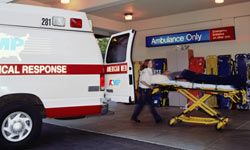We've all experienced it at one time or another. Maybe you or a family member has been injured or developed a fever or strange rash. Or worse, you're experiencing chest pains or have trouble talking. You know medical treatment is necessary, but is it worth it to go to the emergency room? Is the problem really life-or-death, which is what emergency rooms are designed to handle? Maybe there's an urgent care center (sometimes called a "doc in the box") nearby, or maybe you're wondering if you should just wait until the morning to call your personal doctor.
There's a lot to consider, so let's take a look at some of the guidelines for when to go to the ER. We'll also examine the symptoms of stroke and heart attack, because if you or someone you love is experiencing these symptoms, not only is a trip to the ER essential, but a call to emergency services (like 911 in the United States) can mean the difference between complete recovery and serious problems or death. Next, we'll look at some of the side effects people may experience when undergoing cancer treatment. Some of these may be severe enough to warrant a trip to the ER. Finally, we'll take a look at the symptoms that generally just require a visit to an urgent care center or your own physician.
Advertisement
As you're reading these guidelines, keep in mind that if you're ever unsure about whether the symptoms you or a family member are exhibiting constitute a true emergency, err on the side of caution. If you're on the fence or are having doubts, go to the ER. If it really is a matter of life and death, that's where you need to be.
First, let's talk about injuries: Broken bones, dislocated joints, deep cuts requiring stitches, large wounds, bleeding that won't stop, serious burns or injuries to the head and neck often call for a trip to the ER.
What about illness? Many people think of the flu as just a bad cold or a respiratory problem that comes on nearly every winter. However, severe flu or cold symptoms, including fever, cough, runny or stuffy nose, body aches, headaches and fatigue -- especially in children under five, adults over 65 or people with other medical conditions, such as asthma, heart disease, lung disease, morbid obesity or other chronic conditions -- should be considered dangerous.
Worried about allergies? If you or someone with you has a serious allergic reaction, including trouble breathing, hives or swelling -- either following a meal or resulting from an insect sting or bite -- a visit to the ER may be in order.
Other symptoms that doctors consider serious enough for a trip to the emergency room include:
- Sudden, severe, unexplained pain in the abdomen or back
- Fainting or loss of balance
- Sudden testicular pain
- Intestinal bleeding, which may include symptoms such as blood in the stool or vomit, or vomiting up material that looks like coffee grounds
- Repeated vomiting or diarrhea
- Poisoning or drug/alcohol overdose
Next, let's address immediate emergencies. If you or a loved one is experiencing certain urgent symptoms, don't drive yourself to the emergency room. Call emergency responders immediately. The trained emergency first responders will be able to begin treatment in the ambulance, which may mean the difference between life and death. These emergency symptoms include:
- Choking
- Not breathing
- Head injury with passing out or confusion
- Injury to the neck or spine
- Electric shock
- Lightning strike
- Seizure that lasts more than three minutes
Medical professionals are making great strides in the treatment of strokes, especially when the stroke victim can get to the hospital quickly. In fact, every minute can mean the difference between brain damage and recovery. If you believe someone is having a stroke, call emergency responders immediately, then keep an eye on him or her while waiting for assistance so that you can accurately report the symptoms and how long they've been present to the medical professionals. Symptoms of stroke may include:
- Trouble speaking, including slurring words
- Trouble understanding others
- Confusion
- Sudden numbness or paralysis of the face, arm or leg, particularly on one side of the body or the other
- Vision problems, including blurred or blackened vision or seeing double with one or both eyes
- Sudden, severe headache, often in conjunction with vomiting, fainting or dizziness
- Sudden loss of balance or coordination
To test a person for stroke, the Mayo Clinic recommends "thinking FAST." The FAST acronym stands for "face," "arms," "speech" and "time." First, ask the person to smile and check to see if one side of his or her face droops on attempt. Second, ask the person to raise both arms. See if one droops back down or if the person is unable to lift one arm or the other. Third, ask the person to repeat an easy sentence. Is his or her speech slurred, or does it seem off in some way? Last, call emergency responders immediately if the person is exhibiting any of these symptoms, even if they seem to come and go. The longer a stroke is left untreated, the greater the chance of brain damage [source: Mayo Clinic Stroke].
With heart attacks, the approach is similar. If you believe you or someone else is having a heart attack, call emergency responders immediately. Emergency personnel can begin what may be life-saving treatment in the ambulance on the way to the hospital. Symptoms that may indicate a heart attack include pain or pressure in the chest that may spread to the neck, jaw or back; heart palpitations, which is the feeling of a rapid, fluttering or pounding heart; serious nausea, indigestion or heartburn; trouble breathing; cold sweat; fatigue; and dizziness or lightheadedness [source: Mayo Clinic Heart Attack].
Cancer, already a life-threatening condition, may also present emergency complications. People undergoing cancer treatment can expect to experience a variety of side effects from the treatment, including pain, nausea or diarrhea. The question then becomes: How do you know if the symptoms are normal or cause for alarm? First, discuss any possible side effects of the chemotherapy or other drugs with your physician so that you'll know whether your symptoms are a side effect or something else. Second, pay attention to your body so that you can tell if symptoms are changing or getting worse. If they are getting worse, you may need to visit the ER. Third, the National Comprehensive Cancer Network recommends a trip to the ER if any of these symptoms are present: temperature above 101 degrees Fahrenheit (38.3 degrees Celsius), particularly if you're undergoing chemotherapy; confusion or hallucinations; trouble breathing; rash; worsening pain; trouble swallowing; sudden headache; uncontrolled diarrhea or vomiting; or swelling in the arms or legs.
Studies show that sometimes people go to the ER because they either don't have health insurance or their doctor's office isn't open. As more Americans are added to the health insurance rolls through the Affordable Care Act, the number of non-emergencies in emergency rooms, as well as trips to the ER in general, has been declining [source: Oregon]. If you're not experiencing a life-threatening emergency or symptoms, or if you have health insurance and your own doctor isn't available, an urgent care center -- a same-day medical facility offering non-emergency care -- is a better option than the ER. Consider an urgent care facility if you have symptoms, injuries or conditions such as low-grade fever with no rash; minor cuts, burns or sprains; cold, flu, earache or a sore throat; or minor vomiting or diarrhea.
Finally, please remember that these are just guidelines. If you are concerned about your own health, the health of someone else or unsure about some symptoms, call emergency responders (at 911, or the international equivalent) or go to the nearest emergency room. It may mean the difference between life and death.
Advertisement



